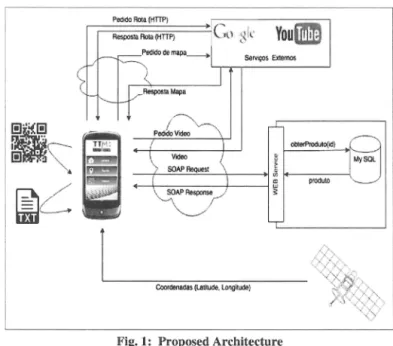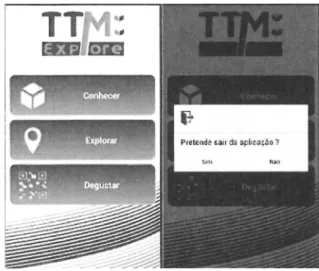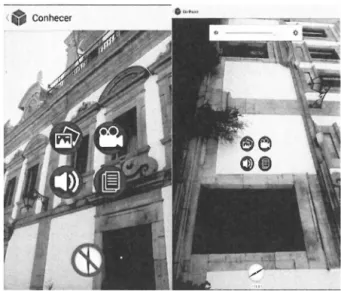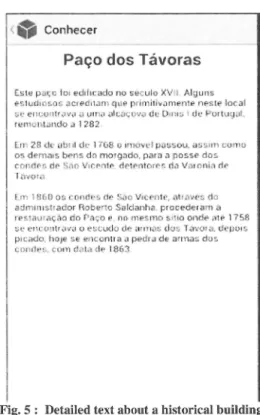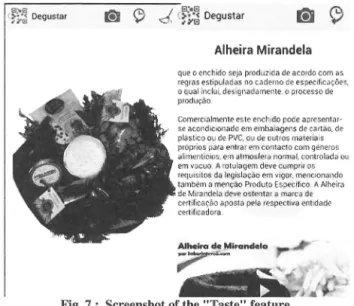(IBIMA)
25-26 April 2018
Milan, Italy
ISBN: 978-0-9998551-0-2
Innovation Management and Education Excellence through Vision 2020
Editor
Khalid S. Soliman
International Business Information Management Association (IBIMA)
Innovation Management and Education Excellence through Vision 2020
Promoting Heritage Through a Pervasive and Mobile Computing
Approach: The Case of the Portuguese City of Mirandela
Carlos R. Cunha, Applied Management Research Unit (UNIAG), Polytechnic Institute of Bragan<;:a, Mirandela, Portugal, crc@ipb.pt
Elisabete Paulo Morais, Applied Management Research Unit (UNIAG), Polytechnic Institute of Bragan<;:a, Mirandela, Portugal, beta@ipb.pt
Ant6nio Alves, Polytechnic Institute of Bragan<;:a, Mirandela, Portugal, antoniomnalves@gmail.com
Abstract
Promoting Heritage is a challenge for all generations. The heritage is a legacy that we inherit from our ancestors and that we should deliver to our decedents. In this sense, the first steep that we should take, after preserve the heritage, is to develop solutions that enable effective and democratic ways to promote it. This promotion starts with the ability that of those who visit this heritage be able to know and enjoy it. Information and Communication Technologies and specifically Pervasive and Mobile Computing represents nowadays a big opportunity to develop innovative solutions capable to inform tourists about heritage and even enable them to experience past realities related to immaterial heritage like ancestral legends, past events and even no longer existing physical patrimony.
This paper starts to make a reflection and the evolution the Information and Communication
Technologies role on tourism and present a technological architecture to respond to the challenge of
promote heritage and inform tourist in their travel experiences. After that, the paper presents also a developed prototype created to the Portuguese City of Mirandela capable to promote its historical and gastronomic heritage and also support the tours of the tourists through its territory. Finally, there are made some remarks about the future growing and directions for technology applied to tourism.
Keywords:
ICT, Tourism, Pervasive and Mobile Computing, HeritageIntroduction
The tourist has always been, more and more, an actor thirsting for information about everything that surrounds him and about which he perceives. It is also demanding as to the mechanisms made available so that it can interact with the environment that surrounds him. Although tourism in Portugal, and in many other countries, represents an economic sector very relevant to national competitiveness, the information tools available to tourists are below capacity to meet the actual requirements. This reality is especially depth in the innermost areas of the country.
Provide mechanisms based on ubiquity, to access information and services, is essential for a new generation for tourists and tourism support systems. The development of solutions capable of
providing experiences of fusion of the physical-virtual is, in our point of view, mandatory to promote
the material and immaterial cultural heritage that, in many cases, is no longer existent, or is no longer visible with its ancient splendour, or even, whose existence is not known to tourists.
pages explaining what he can visit in a particular region. He wants more. He wants to be able to search everything about the visiting region before opting to visit it, want to have real-time support when he is there and also want to share the experience he had with other users, with the certainty that the information provided after the visit, it will be useful to whom to plan to move to the same point of interest. This justify the introduction of news information systems for support tourists and tourism (Watson, 2004), an industry traditionally focused on the application of technologies to support the Business-to-Business model (B2B). With the advent of the Internet some of these services were extended to the client, but according to Watson et al (2002). There are three fundamental problems with the current systems: first , the tourist before the trip has a lot of information, which will have to be filtered, and will have to spend a lot of time to find useful information. Secondly there are few systems that support the mobility of the tourist, and finally after the trip the result of the experiences is not easily shared.
It is at the stage where the tourist is at the place to visit that they notice the biggest failures in the availability of the information. Although the concept of ubiquitous computing is not new, in which it is not necessary a computer to access the information and even the evolution of the devices can lead
to believing that they are "invisible" and are everywhere (Brown & Chalmers, 2003), it is clear that
the evolution in the number of tourist support applications for mobile devices is still small and lacks specially in the countries deep interior regions.
To promote heritage and to enable new and richer cultural experiences, we must develop innovative solutions based on pervasive and mobile computing new opportunities and that meet the desideratum presented.
Information and Communication Technologies
&Tourism
Information and Communication Technologies (ICT) has an important role in the earlier development stages of modern tourism. The first major impact of ICT on the tourism sector was the introduction of the Computerized Reservation System (CRS) in the I 970s. In the 1980s, the Global Distribution System (GDS) emerged, as a logical upgrade to the reservation system, uniting a wide range of services and products and bringing global distribution information structure into the entire tourism sector.
The rapid development of ICT in general and the Internet in particular has dramatically changed the tourism industry. Factors such as a quality site, Digital Marketing, Social Networks, Multimedia, Mobile Technologies and Smart Environments are some examples (Morais et al., 2016).
ICT have provided a new mode for cooperative relationships among the members of the various
distribution channels (Buhalis & Law, 2008). The formation of these cooperative relationships has
been facilitated and encouraged by three major factors: interdependence among a wide range of goods and services (all part of the final tourist product), the small size of many individual operators,
and spatial separation between the vacation and the home, (Fyall & Garrod, 2004; Wang &
Fesenmaier, 2007). Beyond these particular factors of the tourism sector, the intensity of information exchange among companies operating in the same distribution channel has led to greater efficiency, as increased information exchange highlights shared interests and common goals, which in turn
facilitate collaboration (Spralls, Hunt, & Wilcox, 2011).
Innovation Management and Education Excellence through Vision 2020
(Buhalis and Jun, 2011). The internet has become a place for consumers to search for tourism-related information, purchase tourism products and services, and obtain others' opinions. Uncertainty about the safety of online tourism bookings and transactions influenced early streams of research to focus on security (Kim et al. , 2006), privacy (Lee and Cranage, 20ll) and trust (Wu and Chang, 2005). Particularly, security was considered the most important consideration for on line booking (Kim et al. , 2006). Increases in consumers' adoption and use of web-based platforms in tourism and hospitality services created website quality concerns, thus influencing research on website design quality (Ku and Chen, 2015). Ease of navigation and information quality became important considerations for attracting and retaining customers, as user-friendly websites enhanced information search and helped tourists arrive at quick decisions (Ku and Chen, 2015). Meanwhile, Destination Marketing Organizations (DMO) realized that the internet offered abundant opportunities for their operations. As a result, websites were designed to reflect destination attributes, thus influencing the perceived image of the destination and creating a virtual experience for the consumer. Moreover, the emergence of Web 2.0 redefined consumers' adoption of e-tourism. Web 2.0 is defined as " a wide array of electronic applications (e.g. , social networks , review websites, blogs, interactive websites and photo-and video-sharing platforms), which facilitate interactions among individuals photo-and among companies and users". Through these platforms, especially social media, consumers easily form communities of members who share similar interests in a structured set of social relationships (Zhu et al., 20 16). Thus, experiences with tourism products and services are shared in the form of photos, comments and reviews and are easily accessed by others. Marketers also share content to promote their products; however, consumer-generated media are perceived to be more trusted and sincere, constituting the real experience(s) of the creator (Wang, 2012). Consequently, reading content about tourism products and services has become an important pre-trip decision-making process (Tsao et al., 2015).
Furthermore, the market penetration of mobile technology (Shaikh and Karjaluoto, 20l6) also influenced the adoption of tourism products and services. The ubiquity, flexibility, personalization and dissemination features of mobile technology make it a veritable tool for both marketers and consumers in tourism and hospitality services (Kim et al., 2008). For consumers, the functionality of mobile technology, such as the ease of access to travel information and trip guides, is an essential feature of its increased adoption, whereas for marketers, it is the opportunity to send marketing messages to a targeted audience.
However, individual differences detennine mobile technology adoption in tourism and hospitality services.
The influence of ICT on tourism receives even more attention with the advent of smart tourism. Smart tourism, defined as the convergence of tourism content, service, and IT devices (GooglePlay, 2016) , helps tourists to extend their cognitive boundary of travel planning with the destination details visualized and enhances the decision quality with data-driven, context-specific recommendations. As such, smart tourism greatly extends and sets apart from the earlier "e-tourism," which provides information via websites in pre-/post-travel phase, by offering smart technology-mediated tourism
experiences through information aggregation, ubiquitous connectedness and real-time
synchronization. As a result, smart tourism provides more relevant information, greater mobility and better decision support over e-tourism (Gretzel et al. , 2015).
Proposed Architecture
• To Know: The ITG provide geo-referenced information in a contextual and automatic way. In this way, the tourist, when traversing a given space, will receive alerts on all the important aspects that are indexed to the space where the tourist meet. Alerts will provide multimedia information (e.g. text, images, audio reports, video). In this way the tourist can freely walk through the space, regardless of his knowledge about the same, being informed about his surroundings and being able to, if he does, obtain more detailed information from the ITG about some aspect about which he was alerted.
• Tour: The ITG provide pre-defined routes, so that the tourist can start a pre-defined
structured knowledge process. This experience could be a small pedestrian route or a route that involves the visit of several points geographicall y dispersed by the Municipality of Mirandela. This strand can be catalogued according to predefined strands (e.g. architectural interest, gastronomic, landscape).
• Build and Share: The ITG allow the tourist to build their "travel album", that is, with each
interaction with the system the tourist will be, if they wish, to build the memory of their own enjoyment. This functionality is, in practice, the construction of a small digital album that will show the places that were visited, as well as the comments that the touri st may have made on those places and finally the photographs that the tourist indexed to those places. Finally, the tourist, at any moment, can share in their social networks, what they are experiencing.
• Support: The ITG provide gee-referenced support information to the other pillars previously
presented. In this way, knowing that the tourist lacks several services to support his own human condition, geo-referenced information about utilitarian services such as hotel and catering, pharmacies and other public services are available. This information is extremely useful in any travel process. Lastly, the ITG have a "panic button" that automatically generates an alert to the competent authorities with the geo-referenced location of the tourist, if there is a tourist information record in the application.
• Understand and Evolve: The lTG can store, without violating the privacy of tourists,
information about the activity developed by them. In this way, it will be possible to better understand the behavior of tourists so that actions can be developed to continuously improve the experiences provided within the expectations of the tourists and scrupulously fulfilling the respect of their privacy.
Innovation Management and Education Excellence through Vision 2020
YouiB
Fig. 1: Proposed Architecture
In the proposed architecture is presented a multi-platform integration perspective where a tourist through a smartphone mobile application, using its multiple sensors and Internet enabled, can query a Webservices platform and also interact with external services providers. Develop effective and lasting solutions to promote Heritage itself but also business geared by heritage can only be a reality through a cooperation perspective where several independent platforms feed mobile applications needs.
For validate the proposed architecture, we have developed a prototype focus in the Portuguese city of Mirandela, where heritage is a mix of architectural patrimonial , gastronomic heritage and also beautiful landscapes that enable several tours (mostly walking in old historical rails). The prototype main goals have been support the tourists' information needs about Mirandela heritage, about is gastronomic products and support the tourist needs when they decide to walk in the historical rails , that in Mirandela case, can many times be outside of the city in paths through the fields from the city to its small villages.
The Developed Prototype
The use of mobile applications in everyday life is an increasingly present reality, and this reality, in our opinion, has come to stay.
Applications are able to meet the constant need for access to information in a simple and effective way, bringing many benefits both professionally and personally. Its use goes not only through the search for communication, but also through help in the most diverse tasks of everyday life. More than 95% of people use digital tools before, during and after their journeys in search of the best travel experience (Guggenheim et. al., 2014).
This prototype is mobile application where it is possible to make known Mirandela as a Smart City in
• Make Mirandela city more "Smart".
• Provide product information since Mirandela city is well known for its regional products
(e.g. "Alheira" that is a bread, olive oil and meat sausage, and that was nominated in 2011 as one of the seven Portuguese Gastronomic Wonders).
• Allow the user to explore fantastic locations that exist in Mirandela city, thus providing
good moments to the user;
• Inform the user of monuments through information, the evolution, in the time, that have
existed in this monument, among others features.
Above are presented some screenshots of the Android App that have been developed as a Proof-of-Concept of the proposed architecture named "TTM Explore".
In Fig. 2 we can see the main menu of the Apps that represents three main perspectives: "Conhecer" (To know), " Explorar" (Explore) and "Degustar" (Taste). This three issues reflects the ability of obtain information about the heritage, explore historical rails and finally Taste the regional gastronomy (i.e. obtaining information about gastronomic products and also such as recipes, where to buy, where to taste them).
Fig. 2 : App main menu
Innovation Management and Education Excellence through Vision 2020
<0
ConhecerFig. 3 : Screenshot of a historical building
, . Conhecer
Pa~o
dos Tavoras
E.s tf:! p a -;c l ot edthcado no sec ul o .XV I AI guns
t? ~ 1 ud• n- ~o~ .;~ c r Pdll~lmqut- p r itn it iV.;Ifl lf'f111? ne-!< lt"' loc ~ 1l
t::l' eut : u r atr~I'N {.I Lr!rl,t -i.'h..:tlc;ov.;:• <h.: 0 ntG I de Portli.;.Ji.d .
r~111 o nt~ndo .J 1282 . ·
Em 28 dl· t •tJ T tl tit• 17 G8 u tnlOVl'l J >-L.I~-;Ou, iJiS :..;un cumn os d emrus bPns d.n morgado, para a posse do s c onnr-r. dP. Sno V er.P 1P <I.PtN11 0r!"'f. d;l V ~ 1 o n in rlP
l iWOI
l• 18btt O!; r"Oncte s de s,,, o Vtct:nt e,
"'t'"· ..
e s d .oadmlllt s.trador Robe·io Saldanha . pro ceder am a
fP . t8llf21f; i10 do f'A C O P Jlll 01 P .S il10 S. tl!O Qnd,..,.. <11P 1 7 58 ~· .. : t••u..: ontF.lii'.J (,) e-t;(cl•d-u d e rul • tato do t. l .twora. th:' IJVt :..
p tcado httJe se enc ontta a pe dra de atmas dos. cotl d t> :.. .. c om tlv ta de 1863
Fig. 5 : Detailed text about a historical building
The App perspective named "Explore" is presented in Fig. 6 where three screenshots are presented. The image shows some information about an historical building and how to go from the present geographical point of the user and the giving historical building. The picture shows that the user can have some multimedia information about the Point-Of-Interest (POI) and, if the user decides to visit
it, he can obtain the route between is current position and the POl. 1t is used the Google Maps along
to the smartphone GPS sensor as the feature engine.
~
j;
A
(
9
ExplorarDistancia:-. 4535 metros TemPQ:- 63 .49 minuto:: Olfi(u!dadc:Oifi<.il
L<~ titude : 41.4853203
Lonc ; it ud ~ : ·1_1 $1889
i
~~
I
lfB
<9
Explorar+
Pa~o dos Tavoras
[~tt p~~-o to r eoifica\b M J.it.vlo XVII. Alyurt'.
~~ tudir.~os <arre di tam qu~ pr imi t r.~ n rtli'l'lh! nPSte local
51."encontrJva a un"~Jak<i~ov a deDi nis ldf> P o rtug<~l.
rernontvndoa128l
Fm 28 d~ 3bfll dto 1768 oJmrhel passou. 3 ~ s1 m ~ . orr.o
osd ll"m a i sMnsdomo.rg.ldo . p:v <i t~posMdM
r ondP!> de- S;JO Vi r ~n t e . d et~torh da VMOma de
Innovation Management and Education Excellence through Vision 2020
Finally, Fig. 7 presents two screenshots about the feature "Taste" . We have put QR Codes tags in regional gastronomical products. With this tags we can link the gastronomic products to multimedia information related to these products. From products traceability issues, recipes videos about how to cook the product or where to buy the product, there are several possibilities available to the user.
I \!l:•B <'· < ~>-~ Degustar
Alheira Mirandela
que o enchido sejn produzida de acordo comas regra s estipu ladas no caderno de especific<1c;6es. o qual inclui. de signadamente, o processo de produ.;a o
Gomercialmente este enchido pode a pre se nt ur~
se acondicionado em emba lagens de cartao. de pla stico o.u de PVC. ou de outros ma teria is pr6prio s pa ra en tra r em contact a cam gfmeros
a!irnenticios. em atmosfera normal. contro lad a ou
em vacuo A rotu lagem deve cumprir os req uisites da l egi s la ~a o em vigor, mencionando tamb€m a mencao Produto Especifico A Alheira de Miran dela deve ostentar a marc a de crrt ificac;ao aposta pela respectiva ent!dade cert ifica dora.
Fig. 7 : Screenshot of the "Taste" feature
The presented prototype application has been developed to Android smartphones but in the future we intend to enable it also to iOS users. Further information, about the use of this App, could give us important data for future improvements and further discussion of our approach.
Conclusion and Final Remarks
The use of ICT in tourism is a reality. From the future we only expect to have a tourist profile more and more demanding about the capacities and quality of the existing technological solutions in the field of tourism. From the truly democratization of the World Heritage, through ICT solutions of virtual reality enabling everyone to enjoy of the civilizational heritage; to the ability to enabling us to pass on to future generations the heritage we inherit (without lapses or cuts) lCT has a fundamental role to play in rebuilding, informing and making people experience the heritage that is fundamentally of all of us.
This paper has discussed the importance and evolution of the JCT role in the tourism context. It presents an architecture and a proof-of-concept prototype as a contribution for the design of better and more innovation ways of bridging the gap between tourist and tourism entities needs, promoting the heritage and driving business opportunities and a better cities promotion.
Acknowledgments
UNIAG, R&D unit funded by the FCT - Portuguese Foundation for the Development of Science and Technology, Ministry of Science, Technology and Higher Education. UID/GES/4752/2016.
References
Brown, B. & Chalmers, M. Tourism and mobile technology, Paper presented at the Proceedings of the eighth conference on European Conference on Computer Supported Cooperative Work, 2003.
Buhalis, D. , 1996. Information technologies as a strategic tool for tourism. Tourist Rev. 51 (2) , 34-36.
Buhalis, D., 2000. Tourism and information technologies: past, present and future. Tourism Recreation Res. 25 (I) , 41-58.
Buhalis, D. , & Law , R. (2008). Progress in information technology and tourism management: 20 years on and 10 years after the Internet-the state of e-tourism research. Tourism Management, 29, 609e623.
Buhalis, D. , Jun, S .H., 2011. E-tourism. Contemp. Tourism Rev., 0 l - 38
Kim , W.G. , Ma, X ., Kim, D .J. , 2006. Determinants of Chinese hotel customers' e-satisfaction and purchase intentions. Tourism Manage. 27 , 890-900.
Kim, D., Park, J ., Morrison, M., 2008. A model of traveller acceptance of mobile technology. lnt. J. Tourism Res. I 0, 393-407.
Lee, C.H., Cranage, D.A., 2011. Personalization - privacy paradox : the effects of personalization and privacy assurance on customer responses to travel Web si tes. Tourism Manage. 32, 987- 994.
Guangnian , X ., Zhicai J., Chunqin , Z. , Travel mode detection based on GPS track data and Bayesian networks, Computers, Environment and Urban Systems, Volume 54, 2015 , Pages 14-22, ISSN 0198-9715
Morais, E. P. ; Cunha, C . R.; Sousa, J. P.; Santos, A. (2016) - Information and communication technologies in tourism : challe nges and trends. ln 27th International Business Information Management Association Conference - Innovation Management and Education Excellence Vision 2020: from Regional Development Sustainability to Global Economic Growth . Milan. p. 1381-1388 .
Wu, J. , Chang, Y., 2005 . Towards understanding members' interactivity, trust, and flow in online travel community. lnd. Manage. Data Syst. 105 (7), 937- 954.
Ku, E.C.S., Chen, C ., 2015. Cultivating traveler's revisit intention to e-tourism service: the moderating effect of website interactivity. Behav. In f. Technol. 34 (5) , 465-478.
Zhu, D.H ., Chang, Y.P ., Luo, J.J., 2016. Understanding the influence of C2C communication on purchase decision in online communities from a perspective of information adoption model. Telematics Inform. 33 (1) , 8- 16.
Innovation Management and Education Excellence through Vision 2020
Tsao , W. , Hsieh , M., Shih, L., Lin , T.M.Y., 2015. Compliance with eWOM: the influence of hotel
reviews on booking intention from the perspective of consumer conformity. Int. J. Hospitality
Manage. 46, 99-111. http ://dx.doi.org/ 10.101 6/j.ijhm.2015.01.008.
Gretzel, U., Sigala, M., Xiang, Z., Koo, C., 2015. Smart tourism: foundations and developments.
Electron. Mark. 25, 179-188.
GooglePiay, 2016. Smart tourism Taiwan. Advanced Research Institute, Google Android App.
Fyall, A., & Garrod, B . (2004). Tourism marketing: A collaborative approach. Cleveland: Channel
View Publications.
Spralls, S. A., Hunt, S. D ., & Wilcox, J. B. (2011). Extranet use and building relationship capital in
inter-firm distribution networks: the role of extranet capability. Journal of Retailing, 87( I ), 59e74.
Wang, Y., & Fesenmaier, D. R. (2007). Collaborative destination marketing: a case study of Elkhart
country, Indiana. Tourism Management, 28, 863e875.
Wang X. Smart tourism or intelligent tourism? China Tourism News, 2012-04-20(11).
Watson, R. , Akselsen, S., Monad , E., Pitt, L. The open tourism consortium: laying the foundations for the future of tourism ll European Management Journal, vol. 22, issue 3, 2004, pp. 315-326.
